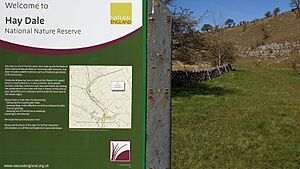Hay Dale facts for kids
Quick facts for kids Hay Dale |
|
|---|---|

Hay Dale on the Limestone Way
|
|
| Length | 0.75 miles (1 km) north–south |
| Width | 120 metres (394 ft) |
| Depth | 30 metres (98 ft) |
| Geography | |
| Location | Derbyshire, England |
Hay Dale is a beautiful, dry valley in the Peak District of England. It's close to the town of Buxton in Derbyshire. This valley is part of a longer stretch of land that goes for about 4 miles (6.4 km). It runs from Peak Forest down to the River Wye at Millers Dale. Along its path, this valley has different names. From the north, it is called Dam Dale, Hay Dale, Peter Dale, and Monk's Dale.
Contents
Discovering Hay Dale
Hay Dale is a short valley. It is about 0.75 miles (1.2 km) long and 120 meters (390 ft) wide. The valley floor is gentle and easy to walk along. On both sides of the valley, there are flat areas of farmland.
A Special Nature Reserve
Hay Dale is part of the Derbyshire Dales National Nature Reserve. This reserve is managed by Natural England. It protects five different dales in the White Peak area. These dales are Lathkill Dale, Cressbrook Dale, Hay Dale, Long Dale, and Monk's Dale.
Ancient Rocks and Ice
The rocks you see in Hay Dale are called Carboniferous Limestone. They were formed about 350 million years ago. Back then, this area was covered by a warm, tropical sea. The shells and sediments from that sea created the limestone. Later, about 20,000 years ago, huge sheets of ice from the last Ice Age shaped the landscape. They carved out the valleys we see today.
Plants and Animals
Hay Dale is home to many interesting plants and animals. You can find ash woodlands and grasslands on the limestone. Many beautiful wildflowers grow here, especially in spring and summer. Look for the early purple orchid and cowslip. You might also spot the common rock rose and thyme. Butterflies are very common in the dale. One type you might see is the brown argus butterfly.
Exploring the Valley's Paths
Hay Dale is a great place for walking and exploring nature. Several long-distance footpaths pass through the valley.
Famous Walking Routes
The Limestone Way is a popular long-distance footpath. It runs right along the gentle floor of Hay Dale. The Peak District Boundary Walk also follows this path through the valley. At the northern end of Hay Dale, the Pennine Bridleway crosses over. This path separates Hay Dale from Dam Dale. About 1 mile (1.6 km) north of Hay Dale, the Limestone Way crosses a road called the A623. Near this crossing, you can find the route of an old Roman road called Batham Gate. It used to run east to west.
How to Visit Hay Dale
You can reach Hay Dale from different directions. If you are coming from the north, you can follow a footpath from Peak Forest. This path goes through Dam Dale first. If you are coming from the south, you can get to the dale from the village of Wormhill. From Wormhill, you can follow the Pennine Bridleway and walk through Peter Dale. A small road running west from Wheston marks the southern end of Hay Dale. This is where Peter Dale begins.



